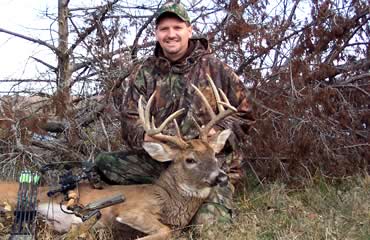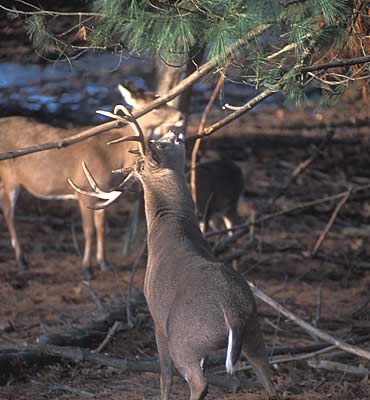Not all rubs will produce bucks, but they all tell a story about the deer who make them.
Over the last 25 years, I’ve been fortunate to find a handful of deer hunting gems — special places with just the right ingredients to make them consistently productive. I discovered one while scouting one day after the season had already begun. A 200-acre woodlot tapered down to a funnel roughly 250 yards long that emptied into a 25-acre tangle of dense bedding cover. That might have been narrow enough for a gun hunter, but the proximity of nearby houses limited the area to bowhunting. I had to narrow the possibilities further.
It took several passes up and down the bottleneck to sort out the mystery. There was a network of well-used trails, and I needed to locate the right one to set up on. I found the clue I needed in the form of several freshly rubbed saplings astride a well-used trail. I didn’t have time to hang a stand that afternoon and didn’t want to make too much commotion the next morning. I decided to set up in the crevice of a small rock outcropping. It would offer just enough cover to draw my bow, assuming the deer came from the direction I anticipated.
It was full daylight the following morning when I heard a scuffling sound in the dry oak leaves just uphill from my ambush spot. At first, all I could see was glimpses of brown and white through the thick underbrush. Then I caught a glint of antler. This was it. I tried to time it so my draw would be concealed from the buck’s view as he passed behind a large oak. It worked, and I was at full draw when he stepped into the narrow shooting lane and stood broadside at 30 yards. It was a handsome, mature 8-pointer, and from there it should have been game over.
Unfortunately, I didn’t see the pencil-thin sapling standing halfway between us. My arrow found it, though, deflecting harmlessly into the branches of a deadfall pine with a clatter. I didn’t get that buck but consoled myself with the knowledge I had managed to put myself in the right place at the right time, thanks to the rubs. I also hung a stand and have used it successfully in every season since.
There’s all sorts of sign in the deer woods that we can use as clues to solving the whitetail riddle. Finding them is helpful, but being able to understand and interpret them is even more useful. Rubs are one of my favorites.
 Why Bucks Rub
Why Bucks Rub
The gradual diminishing of daylight triggers a physiological response in deer, and more testosterone is secreted into the bloodstream. The first observable result is a cessation of blood supply to the antlers. The velvet dries and begins peeling off the now-hard bone antlers. Does it itch? Probably not, except perhaps in the case of a button buck, where the “antlers” consist only of a small button of skin. But it’s got to be annoying to suddenly have all that dead tissue hanging down in your face.
Deer flick their tails and ears at pestering flies and use their legs to scratch where they can. It only follows that they would do whatever they can to rid themselves of velvet, including rubbing. The whole process takes less than 12 hours and occurs well before most hunting seasons. Those early rubs are of little value to hunters, unless you have a very early season.
During the late summer/early fall, bucks are very regular in their daily patterns. They also tend to occupy relatively small home ranges and are still in bachelor groups. A fresh rub is a good indication the buck that made it is close by — and not alone. When you find such a rub in the early season, get back to hunt it soon, because this little hotspot won’t last.
Let the Games Begin
Rubs made later are usually more important to most hunters. In fact, rubbing activity increases over time. That again begs the question: Why do they rub? The simple answer is because that’s what nature programmed them to do. Though deer almost certainly have no comprehension of why they rub, it serves a very important purpose.
Think of deer as athletes. They need to get in shape before the regular season — in their case, the rut. Deer begin the preseason (pre-rut) with casual rubbing and sparring. As the days grow shorter and the regular season draws closer, they get another surge of testosterone. This increases their aggressiveness and helps them bulk up. In a well-balanced herd, mature bucks will have to fight for dominance and breeding rights. The strongest and most aggressive will usually be the victors.
These rubs are of some use to the hunter. They tell us there is at least one buck in the woodlot. We might even be able to get some indication of how big it is. When you see fresh rubs in the fall, the pre-rut has begun.
 Multiple-Use
Multiple-Use
Rubs have several other functions that are more important to both deer and hunters. They also serve as signposts. When a buck rubs out of aggression, he also deposits scent from his forehead and preorbital glands. More often, a buck rubs not out of aggression, but to purposefully deposit scent, and it is these rubs that are of greatest value to the hunter.
Rather than random locations throughout the forest, scent-post rubs are typically located along a route frequently used by the buck that made them, and quite possibly by other bucks. I intentionally used the word “frequently” rather than regularly because while bucks use this type of rub more often, there’s no telling when that might be. However, there are some hints.
Traditional rubs, and even regularly used non-traditional rubs, seldom occur alone. More often, if you scour the area, you’ll begin to see a pattern or route of travel that the buck or bucks followed when rubbing. This is called a rub line. If you look more closely, you might also see the trees on a rub line tend to be rubbed on one side.
Now extrapolate this into the big picture. What lies at the beginning and end of the rub line? The side that’s rubbed is the direction the buck was coming from; the clean side is where he was going. If the direction of travel is from bedding to feeding, that’s a good indication the trail is used in the afternoon. If it leads from feeding to bedding, odds are better it’s a morning route. Remember that these are generalities; and there are exceptions to every rule.
There is less evidence regarding how important rubs are as visual signposts. However, we’ve already seen from scouting and hunting just how well rubs stand out in the woods, even from a distance. They draw our attention, and it seems reasonable to suppose they do the same for deer. To a certain extent they do, and we can take advantage of this. Though they’re less effective than mock scrapes, you can occasionally use mock rubs to put deer where you want them.
Branch Out
There is another type of rub that is worth mentioning. Most hunters probably don’t even recognize it as a rub, yet it might be the most important. Virtually every scrape that deer use on a regular basis has one thing in common: an overhanging branch. It’s usually referred to as a licking branch because deer will, on occasion, lick it. It is far more common for them to rub it with their face, forehead and antlers. In so doing, they deposit scent from several glands.
Every active scrape has a branch, but not every branch has a scrape. Still, they have some things in common. They’ll be on a regularly used trail or route. The area underneath will be open — no branches — up to about 4 or 5 feet. The branch tips will be heavily browsed or broken, often both. You can hunt them as is, or spray some deer scent to sweeten them.
Rubbed the Wrong Way
At the other end of the spectrum are rubs that are of little utility. While you shouldn’t necessarily avoid them, they’re not worth investing a lot of your time. I’ve already mentioned one, the display rub. These are rubs that a buck usually makes only once to display his vigor to another buck rather than engage in direct combat. It’s very likely the same tree will never be rubbed again, and sitting over it will be a waste of time. Another example is the field-edge rub. In most cases, these rubs, even when traditional, are used predominantly after dark. One notable exception is when the field happens to be a food plot.
Conclusion
Deer rub trees for a variety of reasons. Knowing why can help us recognize which rubs are more likely to be productive locations for hunting. Scout, study and look for the ones that will offer you the best odds. They won’t all produce, but those that do can became gems over many seasons to come.
Read Recent Articles: • Why QDM Isn’t Working for You: There are plenty of reasons QDM works ... and just as many as to why it can fail.
• White Smoke and Winter Whitetails: You can still fill your tag with a late-season blackpowder hunt.
• Rubbin’ Up the Wrong Tree: Not all rubs are created equal. Here’s how to determine which you should pay attention to.
This article was published in the August 2008 edition of Buckmasters Whitetail Magazine. Join today to have Buckmasters delivered to your home.